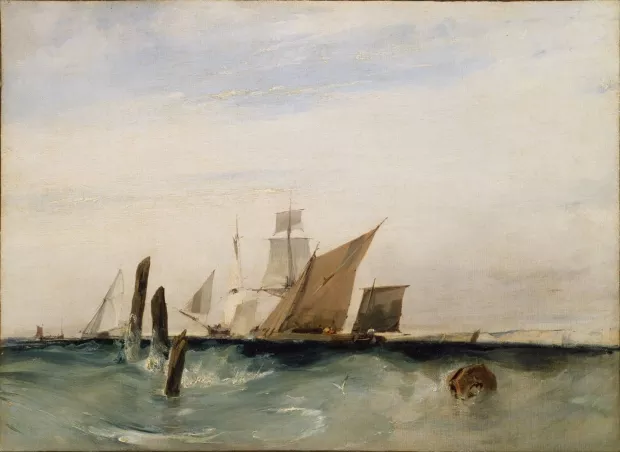Creation Date
1823
Height
38 cm
Width
52 cm
Medium
Genre
Description
Richard Parkes Bonington's Seapiece is an example of Romantic-era depictions of the sea as an unpredictable force. The motion of the waves and the leaning of the smaller vessels help to create this effect. Various ships are visible in the distance, and one ship in full sail sits directly beyond the coastal waters. Three poles emerge from the sea in the left foreground, indicating the shoreline; the crashing of the water over these wooden pieces and the rolling of the waves give the impression of a strong wind. The sea beneath the ships in the distance is significantly darker than the foamy sea near the shore. A distant coastline with cliffs is visible to the right.
During the probable time of the work's execution, Bonington toured Flanders and Belgium (1823), and spent most of 1824 in Dunkirk. However, because the date of completion is not given, it is not clear if he painted the work during this tour or after he had returned to Paris. Bonington's Seapiece is an example of Romantic-era depictions of the sea as an unpredictable force. The motion of the waves and the leaning of the smaller vessels help to create this effect.
This picture demonstrates how the sea lends itself to the Romantic fascination with the unseen and a reality beyond the tangible. The leaning of the ships against the wind, the dipping and crashing of the waves close to the viewer, and the fading images of more ships on the horizon all suggest the continuous, infinite presence of the sea and the essence of nature beyond what is visible in the image. In addition, the felt movement of the waves gives the painting life and instills in the viewer a sense of the sea's ever-changing surface.
In order to suggest the presence of an unknown beyond tangible reality, Bonington rejected traditional rules dictating that art must pay careful attention to detail in order to convey ideological and moral truths. This seascape transcribes "observed natural phenomenon for emotive effect," promoting the experience of beauty over mere representation (Noon 33). The use of naturalistic colors and light to inspire sympathy and emotion parallels the efforts of other Romantic artists to locate aesthetic value in the individual's response to nature. In his work, then, Bonington refers the sensibility and imagination of an individual confronted with a natural scene (like a seascape) to the aesthetic conceptualization of an immense beyond.
Associated Works
Copyright
Copyright, 2009, Romantic Circles.
Collection
Accession Number
1982.55.1
Additional Information
Bibliography
Brook-Hart, Denys. British 19th Century Marine Painting. Suffolk: Baron, 1974. Print.
Gobin, Maurice. R.P. Bonington, 1802-1828. Paris: Braun & CIE, 1950. Print.
Noon, Patrick. Richard Parkes Bonington: "On the Pleasure of Painting". New Haven: Yale UP, 1991. Print.
Paul Mellon Collection, National Gallery of Art, Washington D.C.
"Richard Parkes Bonington." National Gallery of Art. N.p. 2009. Web. 25 March 2009.
Spencer, Marion L. RP Bonington 1802-1828. Exh. Cat. Castle Museum and Art Gallery, Nottingham. 1965. Print.
Tracy, Nicholas. Britannia's Palette: The Arts of Naval Victory. Montreal: McGill-Queen's UP, 2007. Print.
Wilson, Arnold. A Dictionary of British Marine Painters. Leigh-on-Sea: F. Lewis, 1967. Print.

